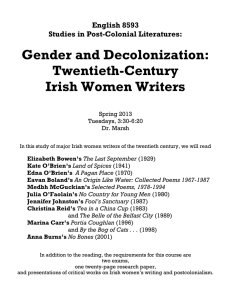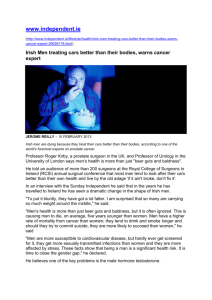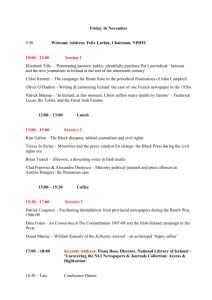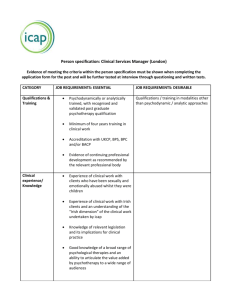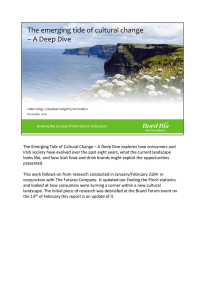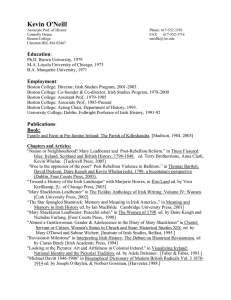Embedded Assessment in Spring Term Courses
advertisement
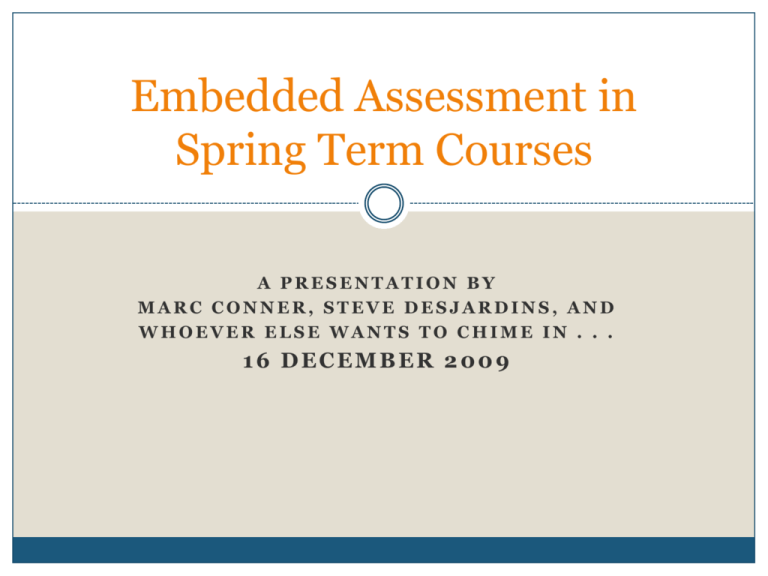
Embedded Assessment in Spring Term Courses A PRESENTATION BY MARC CONNER, STEVE DESJARDINS, AND WHOEVER ELSE WANTS TO CHIME IN . . . 16 DECEMBER 2009 Assessment in the Spring Term How does it differ from the long terms? One added component: the primary learning outcome of the Spring Term Also: we are required as an institution to submit detailed assessment results to SACS each year, because the Spring Term is our Quality Enhancement Plan That all sounds cumbersome and un-fun. Spring Term Assessment The Primary Learning Outcome: to enhance critical and/or creative thinking Really the very essence of the Liberal Arts goal Each course will do this in different ways, specific to one’s own discipline We only need to ask ourselves: In what ways does my course enhance my students’ critical thinking skills? “Critical Thinking” and your own learning outcomes Define “critical thinking” for your specific discipline by connecting it to your department’s established learning objectives Hence, measuring how well you attain one or more of your departmental learning objectives measures how well your course is enhancing your students’ critical thinking—it’s really that simple. “Embedded Assessment” What is it? The easiest—and most effective—means for measuring what you are doing in the classroom. You take something you are already doing, and turn it into a tool of measurement. Thus, without changing your pedagogy or teaching practice, and without adding some monstrous and cumbersome assessment tool, you accomplish your assessment work. Everyone is happy. How ‘bout some concrete examples? Enter Monsieur Desjardins . . . Example from chemistry, the Natural Sciences Followed by Sir Conner . . . Example from English, the Humanities Assessing a Spring Term Course in the Department of English: Spring Term in Ireland An English department learning objective: Students studying English will seek out further knowledge about literary works, authors, and/or contexts In THIS course (derives from this objective): Students will demonstrate an increase in their knowledge of the history, geography, and politics of Ireland The hierarchy of assessment W&L Mission Statement Departmental Learning Objectives Specific Learning Objective for MY course How will I assess this? (I) 1. * Administer initial knowledge quiz at start of winter term orientation class: 20 questions that reflect the sorts of things I want them to know by the end of their immersion in Irish culture * at the end of the spring term experience, students take this quiz again, demonstrating (one hopes) a dramatic gain in knowledge of Irish culture. (administered through the SAKAI program, for easy access in Ireland) How will I assess this? (II) 2. Students write a one-paragraph response to a question about Irish culture during the winter term orientation course; they then write a similar oneparagraph response (to a different but comparable question) at the end of the spring term experience, and the two writings compared will demonstrate a significant increase in their understanding of Irish cultural and political life. (Example: analysis of the Celtic Cross) Assessing a Spring Term Course in the Department of English Another English department learning objective: Students studying English will write clear, persuasive analytical essays driven by arguments about texts In THIS course (derives from this objective): Students will improve their ability to analyze, interpret, and understand modern Irish literature How will I assess this? During the winter term orientation class, students will write a “5-minute paper” on a selected text from a major Irish modernist writer, whom we will study in greater detail during the course Near the end of the spring term experience, students will write another “5-minute paper” on a major Irish modernist writer; the two papers compared will demonstrate a significant gain in the students’ ability to analyze, understand, and articulate the major meanings of these writings. Further steps of assessment These writings may be submitted to an outside evaluator for comparison and assessment. The assessment rubric will include the following questions: [How well – scale] Does the student identify several significant ideas, themes, and issues in the selected writing? Does the student articulate clearly the important elements in the selected writing? Does the student demonstrate clear understanding of the selection’s meaning and importance? Does the student provide analysis of the selection’s technical elements (style, narrative voice, metrical structure, voice, descriptive passage, etc.)? Does the student demonstrate a broader understanding of the cultural context out of which the writing emerges and upon which it comments? Evaluating my assessment work Did I assess everything I did in this course? Not by the longest shot. Did I assess the most important things I did in this course? No way. Did my assessment add a significant amount to my work in this course? Not in the least. Was my assessment work productive and useful? Yep. Other thoughts on assessment You can do much more than what I’ve indicated Assessment can be very, very useful to us as teachers—in fact, we do it all the time, but not always in a self-conscious, quantified, or productive manner Don’t let assessment get in the way of your teaching; rather, find ways to do what you do in the classroom and use it in your assessment work. THAT is “course-embedded assessment.”





